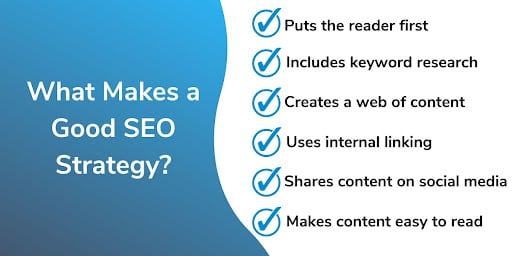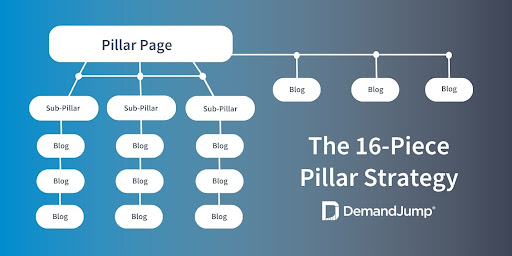What Is an SEO Strategy Document?
February 22, 2023 •McKenzi Moorman

How do you find information online? With a Google search, right? Have those search results ever influenced what you purchased or what services you went on the lookout for? That’s the power of SEO at work. With an effective SEO strategy, your business can wield this power to your advantage.
If you want more visitors to your website, you need an SEO (search engine optimization) strategy. An SEO strategy document outlines how you can increase your brand awareness and guide prospective customers to your site. Creating one for yourself isn’t always easy, though, because you have to write for humans in the language of search engines to make it effective. Luckily, we have some tips for you in this blog, plus a free SEO strategy template for you to try! Let’s dive in.
What Are SEO Strategies?
An SEO marketing strategy is a plan that companies implement to boost their rankings in search results, thus increasing organic traffic to their website. They do so by making the website more readable to search engines and more helpful to human readers. There are four types of SEO that should all be included in an SEO strategy:
- On-Page: Focuses on writing good website content, conducting keyword research, and improving the overall appearance and organization of your website.
- Off-Page: Centers on making your website and its content findable on other websites and social media platforms.
- Technical: Improves the load speeds, navigation, and links of your website to make it easier for search engines to crawl it and for an overall better reader experience.
- Local: Emphasizes creating a “Google My Business” profile and using region-related keywords—such as “restaurants near me”—to make it easier for local readers to find your business.
Not all SEO strategies are created equal. To create a good one, you have to keep some best practices in mind. Keep these practices in a separate document so that you can refer back to them as necessary and change up your strategy as needed.
What Makes a Good SEO Strategy?
A good SEO strategy plan puts the reader at the forefront while also following the standards set by search engines. Google combines these two sides of SEO in their helpful content update. Essentially, this update says that you have to write content that will answer your readers’ questions while showing Google that your content is relevant. To start your strategy, you will need to do some keyword research. These keywords allow search engines to understand what your content is about when pulling up search results. The keywords also show you what people are searching for around a certain topic so you know exactly what to address in your content. DemandJump makes finding those keywords easy.
Next, you’ll want to create a bunch of informative, valuable content about a certain topic. This will show both search engines and readers that your business is an authority on that subject. DemandJump’s Pillar-Based Marketing (PBM) strategy guides you in creating that web of content. PBM also helps you create the internal linking necessary to boost your authority and, thus, your search engine results page rankings (but more on that later).
Outside of the content you post on your website, you can also help your prospective customers out by making it easier for them to find your content (and the solutions to their problems). That means posting about your content on the social media platforms your customers frequently use. It also means setting your content up in such a way that is mobile friendly and easier to read. Including relevant images and breaking up long chunks of text aids in that, as does ensuring that your website is easy to navigate no matter the ability of the reader.

What Is the Best SEO Strategy? Pillar-Based Marketing!
Pillar-Based Marketing is the best SEO strategy out there because it easily integrates with other SEO strategies and does what any good strategy should do: create helpful content for your readers. It works like this: you write three different kinds of content—1 Pillar, 3 Sub-Pillars, and 12 Supporting Blogs—surrounding a topic your business has some knowledge of.
Each of these pieces of content are outlined here:
- Pillar: a broad, 3,000-word piece that uses 20 keywords
- Sub-Pillar: a slightly more specific 2,000-word piece that uses 15 keywords and links up to the Pillar
- Supporting Blog: a specific 750-word piece that used 6-8 keywords and links up to both the Pillar and related Sub-Pillar

To learn more about PBM and to pull the keywords necessary to get you started on creating your SEO strategy for digital marketing, sign up for DemandJump. Not only does our platform provide you with an easy way to create a PBM strategy and track how your content performs, but it also offers you free certification courses on PBM. And as promised, here is that strategy document we mentioned in the beginning.
Featured Articles
Categories
- Attribution Tracking (13)
- Channel Optimization (11)
- Consumer Insights (68)
- Content Marketing (251)
- Data Science (8)
- Digital Marketing (6)
- Digital Transformation (26)
- Enterprise (10)
- Lead Generation (14)
- Market Intelligence (8)
- Marketing Analytics (39)
- Marketing Attribution (57)
- Marketing Management (153)
- Marketing Operations (86)
- Organic Search (222)
- Paid Search (52)
- Pillar-Based Marketing (63)
- Programmatic Advertising (9)
- SaaS Content (14)
- SaaS Marketing (29)
- Search Marketing (111)
- SEO Keyword Research (28)
- SEO Pillar (18)
- SEO Strategy (46)
- SMB (5)
- Website Content (12)


